Qihang Fan
Breaking Complexity Barriers: High-Resolution Image Restoration with Rank Enhanced Linear Attention
May 22, 2025Abstract:Transformer-based models have made remarkable progress in image restoration (IR) tasks. However, the quadratic complexity of self-attention in Transformer hinders its applicability to high-resolution images. Existing methods mitigate this issue with sparse or window-based attention, yet inherently limit global context modeling. Linear attention, a variant of softmax attention, demonstrates promise in global context modeling while maintaining linear complexity, offering a potential solution to the above challenge. Despite its efficiency benefits, vanilla linear attention suffers from a significant performance drop in IR, largely due to the low-rank nature of its attention map. To counter this, we propose Rank Enhanced Linear Attention (RELA), a simple yet effective method that enriches feature representations by integrating a lightweight depthwise convolution. Building upon RELA, we propose an efficient and effective image restoration Transformer, named LAformer. LAformer achieves effective global perception by integrating linear attention and channel attention, while also enhancing local fitting capabilities through a convolutional gated feed-forward network. Notably, LAformer eliminates hardware-inefficient operations such as softmax and window shifting, enabling efficient processing of high-resolution images. Extensive experiments across 7 IR tasks and 21 benchmarks demonstrate that LAformer outperforms SOTA methods and offers significant computational advantages.
DiCo: Revitalizing ConvNets for Scalable and Efficient Diffusion Modeling
May 16, 2025Abstract:Diffusion Transformer (DiT), a promising diffusion model for visual generation, demonstrates impressive performance but incurs significant computational overhead. Intriguingly, analysis of pre-trained DiT models reveals that global self-attention is often redundant, predominantly capturing local patterns-highlighting the potential for more efficient alternatives. In this paper, we revisit convolution as an alternative building block for constructing efficient and expressive diffusion models. However, naively replacing self-attention with convolution typically results in degraded performance. Our investigations attribute this performance gap to the higher channel redundancy in ConvNets compared to Transformers. To resolve this, we introduce a compact channel attention mechanism that promotes the activation of more diverse channels, thereby enhancing feature diversity. This leads to Diffusion ConvNet (DiCo), a family of diffusion models built entirely from standard ConvNet modules, offering strong generative performance with significant efficiency gains. On class-conditional ImageNet benchmarks, DiCo outperforms previous diffusion models in both image quality and generation speed. Notably, DiCo-XL achieves an FID of 2.05 at 256x256 resolution and 2.53 at 512x512, with a 2.7x and 3.1x speedup over DiT-XL/2, respectively. Furthermore, our largest model, DiCo-H, scaled to 1B parameters, reaches an FID of 1.90 on ImageNet 256x256-without any additional supervision during training. Code: https://github.com/shallowdream204/DiCo.
Breaking the Low-Rank Dilemma of Linear Attention
Nov 14, 2024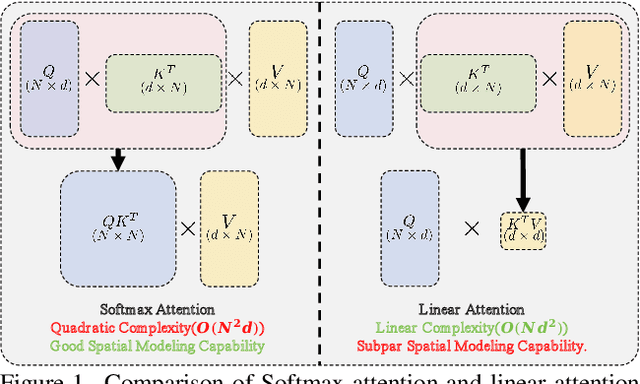



Abstract:The Softmax attention mechanism in Transformer models is notoriously computationally expensive, particularly due to its quadratic complexity, posing significant challenges in vision applications. In contrast, linear attention provides a far more efficient solution by reducing the complexity to linear levels. However, compared to Softmax attention, linear attention often experiences significant performance degradation. Our experiments indicate that this performance drop is due to the low-rank nature of linear attention's feature map, which hinders its ability to adequately model complex spatial information. In this paper, to break the low-rank dilemma of linear attention, we conduct rank analysis from two perspectives: the KV buffer and the output features. Consequently, we introduce Rank-Augmented Linear Attention (RALA), which rivals the performance of Softmax attention while maintaining linear complexity and high efficiency. Based on RALA, we construct the Rank-Augmented Vision Linear Transformer (RAVLT). Extensive experiments demonstrate that RAVLT achieves excellent performance across various vision tasks. Specifically, without using any additional labels, data, or supervision during training, RAVLT achieves an 84.4% Top-1 accuracy on ImageNet-1k with only 26M parameters and 4.6G FLOPs. This result significantly surpasses previous linear attention mechanisms, fully illustrating the potential of RALA. Code will be available at https://github.com/qhfan/RALA.
Semantic Equitable Clustering: A Simple, Fast and Effective Strategy for Vision Transformer
May 22, 2024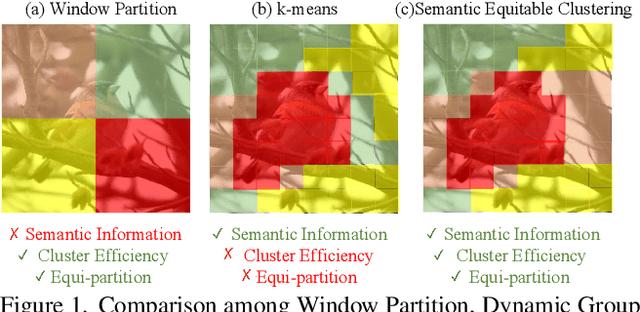
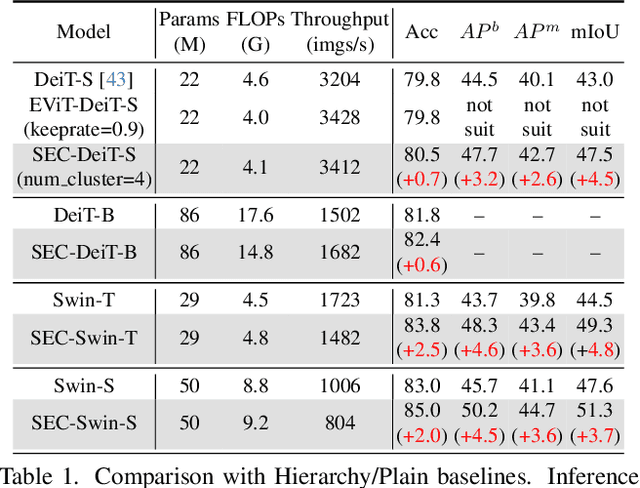
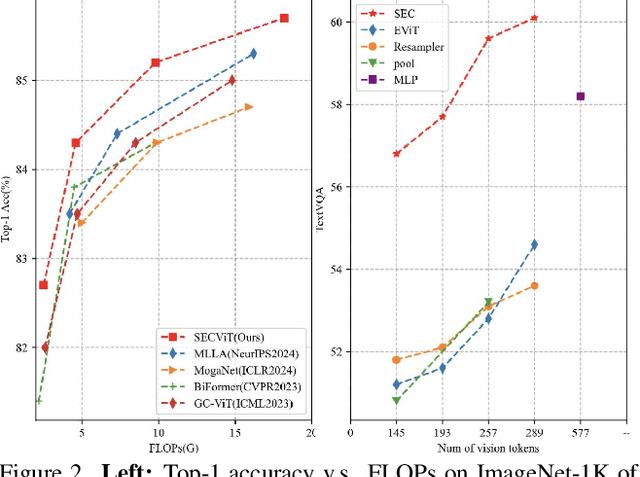
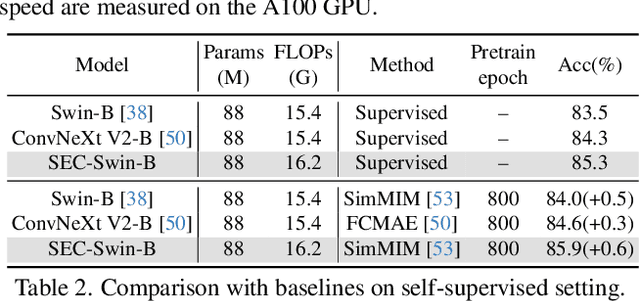
Abstract:The Vision Transformer (ViT) has gained prominence for its superior relational modeling prowess. However, its global attention mechanism's quadratic complexity poses substantial computational burdens. A common remedy spatially groups tokens for self-attention, reducing computational requirements. Nonetheless, this strategy neglects semantic information in tokens, possibly scattering semantically-linked tokens across distinct groups, thus compromising the efficacy of self-attention intended for modeling inter-token dependencies. Motivated by these insights, we introduce a fast and balanced clustering method, named \textbf{S}emantic \textbf{E}quitable \textbf{C}lustering (SEC). SEC clusters tokens based on their global semantic relevance in an efficient, straightforward manner. In contrast to traditional clustering methods requiring multiple iterations, our method achieves token clustering in a single pass. Additionally, SEC regulates the number of tokens per cluster, ensuring a balanced distribution for effective parallel processing on current computational platforms without necessitating further optimization. Capitalizing on SEC, we propose a versatile vision backbone, SecViT. Comprehensive experiments in image classification, object detection, instance segmentation, and semantic segmentation validate to the effectiveness of SecViT. Remarkably, SecViT attains an impressive \textbf{84.2\%} image classification accuracy with only \textbf{27M} parameters and \textbf{4.4G} FLOPs, without the need for for additional supervision or data. Code will be available at \url{https://github.com/qhfan/SecViT}.
Vision Transformer with Sparse Scan Prior
May 22, 2024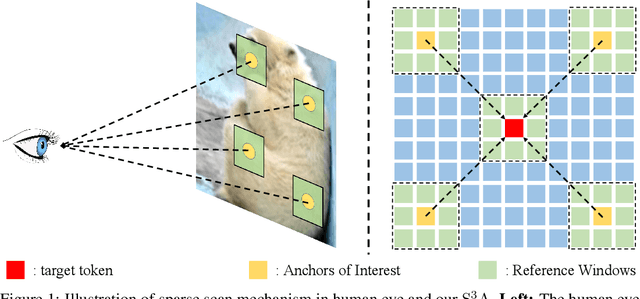
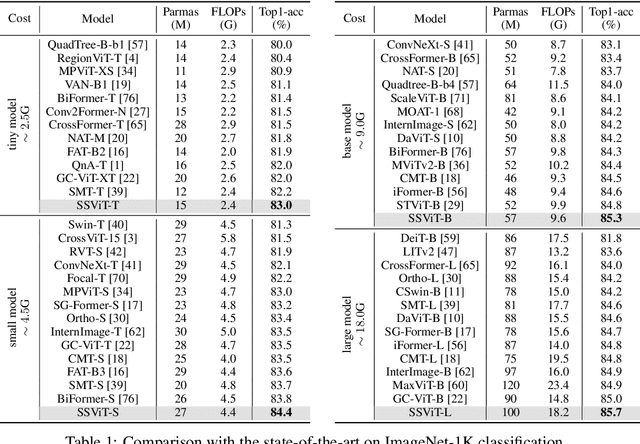
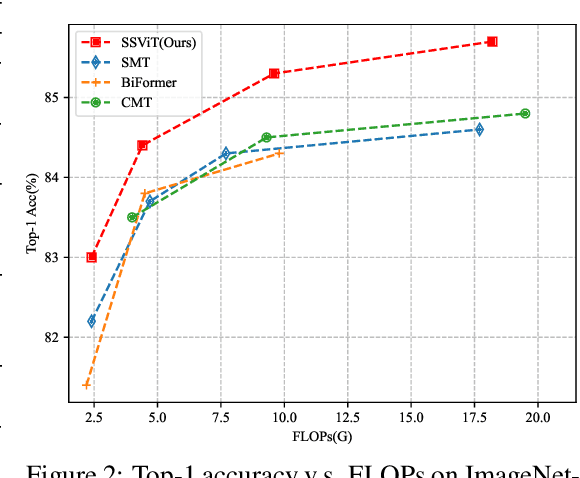

Abstract:In recent years, Transformers have achieved remarkable progress in computer vision tasks. However, their global modeling often comes with substantial computational overhead, in stark contrast to the human eye's efficient information processing. Inspired by the human eye's sparse scanning mechanism, we propose a \textbf{S}parse \textbf{S}can \textbf{S}elf-\textbf{A}ttention mechanism ($\rm{S}^3\rm{A}$). This mechanism predefines a series of Anchors of Interest for each token and employs local attention to efficiently model the spatial information around these anchors, avoiding redundant global modeling and excessive focus on local information. This approach mirrors the human eye's functionality and significantly reduces the computational load of vision models. Building on $\rm{S}^3\rm{A}$, we introduce the \textbf{S}parse \textbf{S}can \textbf{Vi}sion \textbf{T}ransformer (SSViT). Extensive experiments demonstrate the outstanding performance of SSViT across a variety of tasks. Specifically, on ImageNet classification, without additional supervision or training data, SSViT achieves top-1 accuracies of \textbf{84.4\%/85.7\%} with \textbf{4.4G/18.2G} FLOPs. SSViT also excels in downstream tasks such as object detection, instance segmentation, and semantic segmentation. Its robustness is further validated across diverse datasets. Code will be available at \url{https://github.com/qhfan/SSViT}.
Band-Attention Modulated RetNet for Face Forgery Detection
Apr 09, 2024



Abstract:The transformer networks are extensively utilized in face forgery detection due to their scalability across large datasets.Despite their success, transformers face challenges in balancing the capture of global context, which is crucial for unveiling forgery clues, with computational complexity.To mitigate this issue, we introduce Band-Attention modulated RetNet (BAR-Net), a lightweight network designed to efficiently process extensive visual contexts while avoiding catastrophic forgetting.Our approach empowers the target token to perceive global information by assigning differential attention levels to tokens at varying distances. We implement self-attention along both spatial axes, thereby maintaining spatial priors and easing the computational burden.Moreover, we present the adaptive frequency Band-Attention Modulation mechanism, which treats the entire Discrete Cosine Transform spectrogram as a series of frequency bands with learnable weights.Together, BAR-Net achieves favorable performance on several face forgery datasets, outperforming current state-of-the-art methods.
ViTAR: Vision Transformer with Any Resolution
Mar 28, 2024Abstract:This paper tackles a significant challenge faced by Vision Transformers (ViTs): their constrained scalability across different image resolutions. Typically, ViTs experience a performance decline when processing resolutions different from those seen during training. Our work introduces two key innovations to address this issue. Firstly, we propose a novel module for dynamic resolution adjustment, designed with a single Transformer block, specifically to achieve highly efficient incremental token integration. Secondly, we introduce fuzzy positional encoding in the Vision Transformer to provide consistent positional awareness across multiple resolutions, thereby preventing overfitting to any single training resolution. Our resulting model, ViTAR (Vision Transformer with Any Resolution), demonstrates impressive adaptability, achieving 83.3\% top-1 accuracy at a 1120x1120 resolution and 80.4\% accuracy at a 4032x4032 resolution, all while reducing computational costs. ViTAR also shows strong performance in downstream tasks such as instance and semantic segmentation and can easily combined with self-supervised learning techniques like Masked AutoEncoder. Our work provides a cost-effective solution for enhancing the resolution scalability of ViTs, paving the way for more versatile and efficient high-resolution image processing.
Video-Teller: Enhancing Cross-Modal Generation with Fusion and Decoupling
Oct 11, 2023Abstract:This paper proposes Video-Teller, a video-language foundation model that leverages multi-modal fusion and fine-grained modality alignment to significantly enhance the video-to-text generation task. Video-Teller boosts the training efficiency by utilizing frozen pretrained vision and language modules. It capitalizes on the robust linguistic capabilities of large language models, enabling the generation of both concise and elaborate video descriptions. To effectively integrate visual and auditory information, Video-Teller builds upon the image-based BLIP-2 model and introduces a cascaded Q-Former which fuses information across frames and ASR texts. To better guide video summarization, we introduce a fine-grained modality alignment objective, where the cascaded Q-Former's output embedding is trained to align with the caption/summary embedding created by a pretrained text auto-encoder. Experimental results demonstrate the efficacy of our proposed video-language foundation model in accurately comprehending videos and generating coherent and precise language descriptions. It is worth noting that the fine-grained alignment enhances the model's capabilities (4% improvement of CIDEr score on MSR-VTT) with only 13% extra parameters in training and zero additional cost in inference.
Video-CSR: Complex Video Digest Creation for Visual-Language Models
Oct 08, 2023



Abstract:We present a novel task and human annotated dataset for evaluating the ability for visual-language models to generate captions and summaries for real-world video clips, which we call Video-CSR (Captioning, Summarization and Retrieval). The dataset contains 4.8K YouTube video clips of 20-60 seconds in duration and covers a wide range of topics and interests. Each video clip corresponds to 5 independently annotated captions (1 sentence) and summaries (3-10 sentences). Given any video selected from the dataset and its corresponding ASR information, we evaluate visual-language models on either caption or summary generation that is grounded in both the visual and auditory content of the video. Additionally, models are also evaluated on caption- and summary-based retrieval tasks, where the summary-based retrieval task requires the identification of a target video given excerpts of a corresponding summary. Given the novel nature of the paragraph-length video summarization task, we perform extensive comparative analyses of different existing evaluation metrics and their alignment with human preferences. Finally, we propose a foundation model with competitive generation and retrieval capabilities that serves as a baseline for the Video-CSR task. We aim for Video-CSR to serve as a useful evaluation set in the age of large language models and complex multi-modal tasks.
RMT: Retentive Networks Meet Vision Transformers
Sep 20, 2023Abstract:Transformer first appears in the field of natural language processing and is later migrated to the computer vision domain, where it demonstrates excellent performance in vision tasks. However, recently, Retentive Network (RetNet) has emerged as an architecture with the potential to replace Transformer, attracting widespread attention in the NLP community. Therefore, we raise the question of whether transferring RetNet's idea to vision can also bring outstanding performance to vision tasks. To address this, we combine RetNet and Transformer to propose RMT. Inspired by RetNet, RMT introduces explicit decay into the vision backbone, bringing prior knowledge related to spatial distances to the vision model. This distance-related spatial prior allows for explicit control of the range of tokens that each token can attend to. Additionally, to reduce the computational cost of global modeling, we decompose this modeling process along the two coordinate axes of the image. Abundant experiments have demonstrated that our RMT exhibits exceptional performance across various computer vision tasks. For example, RMT achieves 84.1% Top1-acc on ImageNet-1k using merely 4.5G FLOPs. To the best of our knowledge, among all models, RMT achieves the highest Top1-acc when models are of similar size and trained with the same strategy. Moreover, RMT significantly outperforms existing vision backbones in downstream tasks such as object detection, instance segmentation, and semantic segmentation. Our work is still in progress.
 Add to Chrome
Add to Chrome Add to Firefox
Add to Firefox Add to Edge
Add to Edge